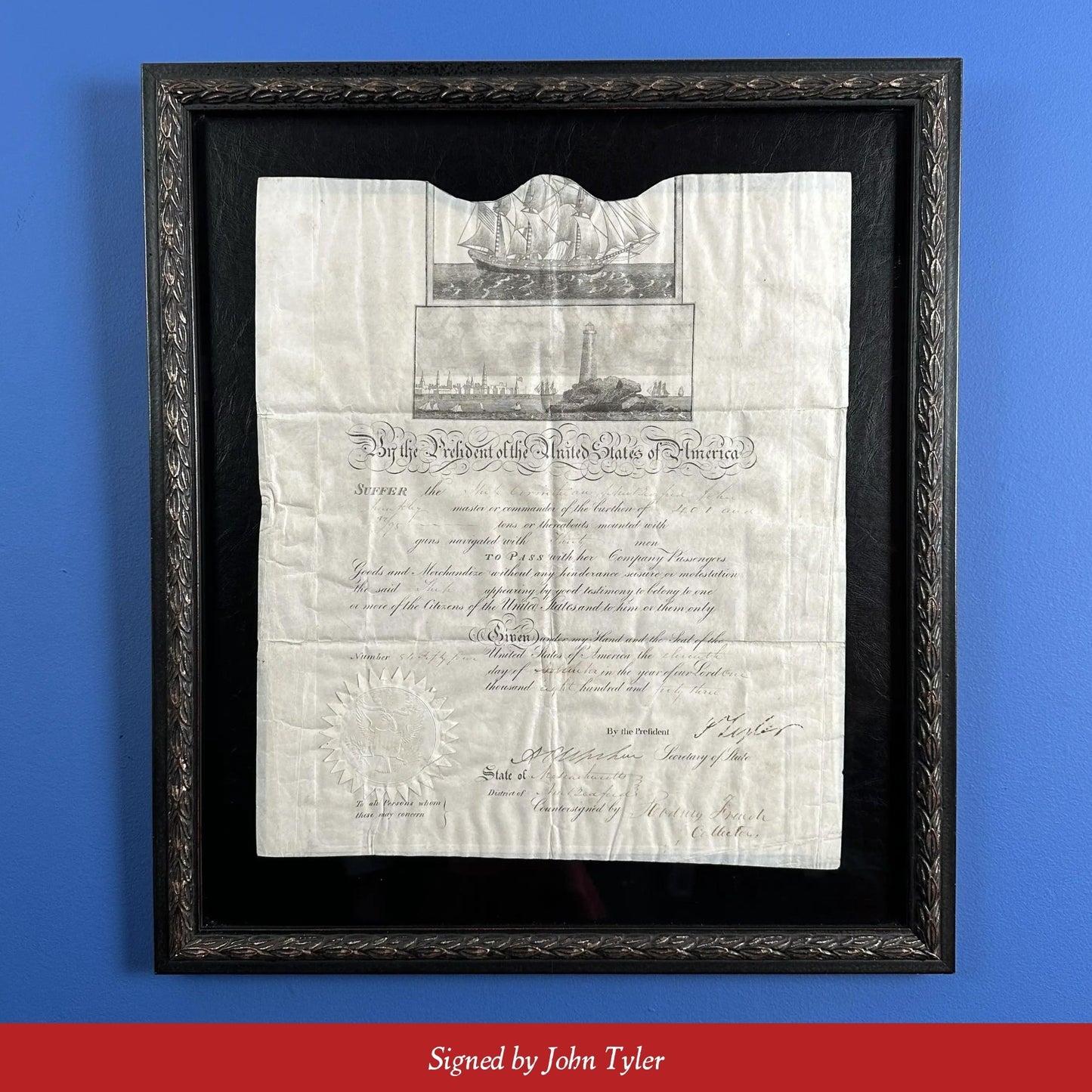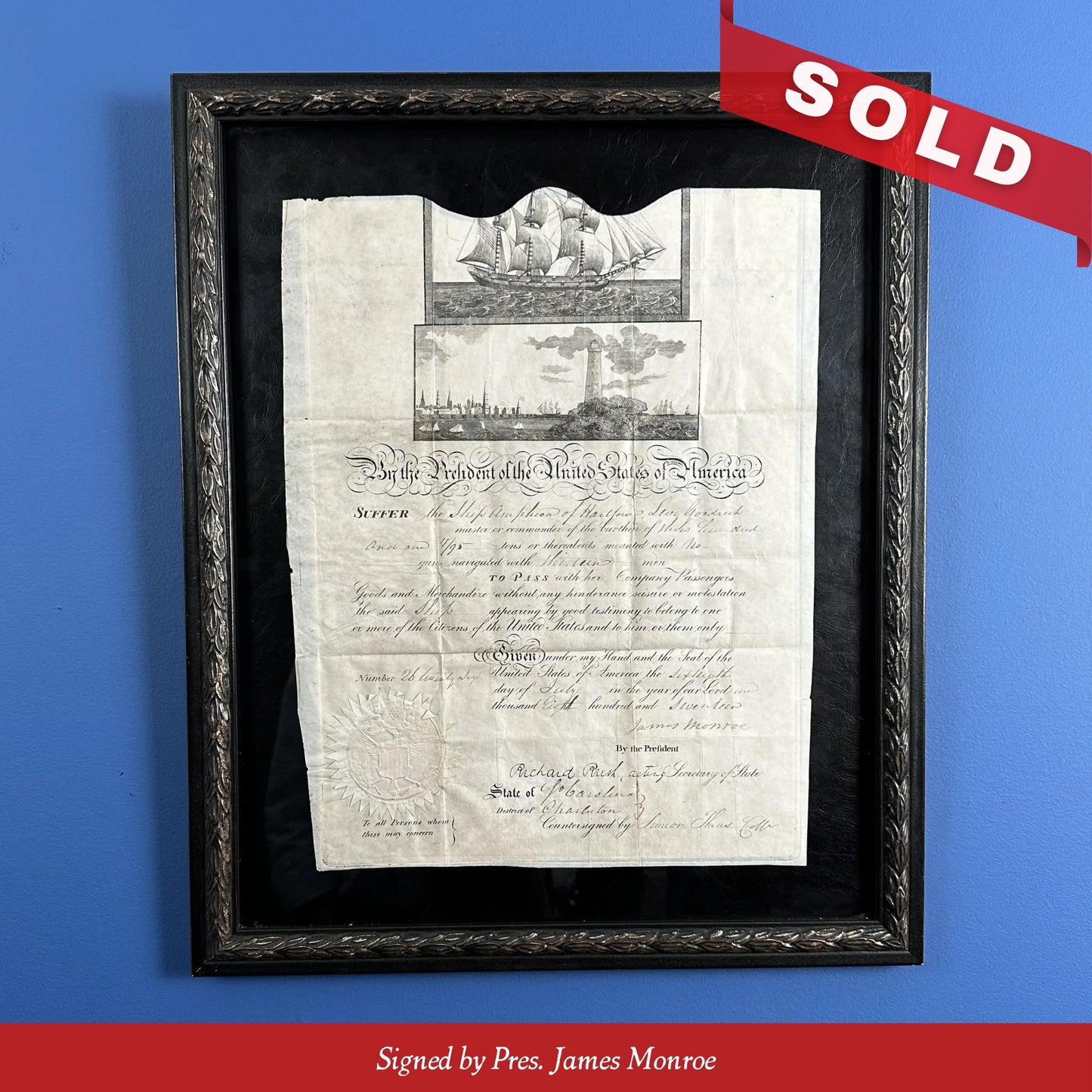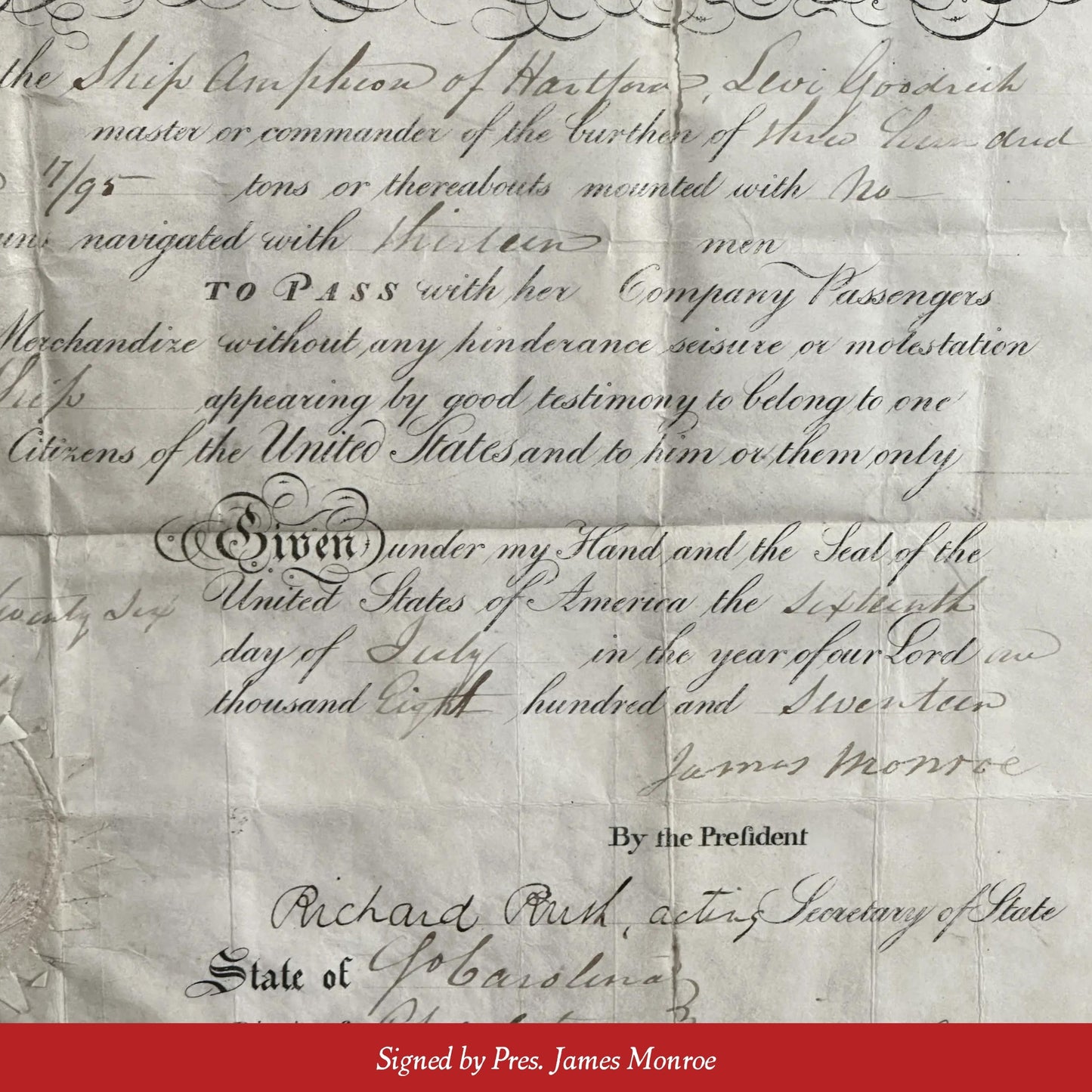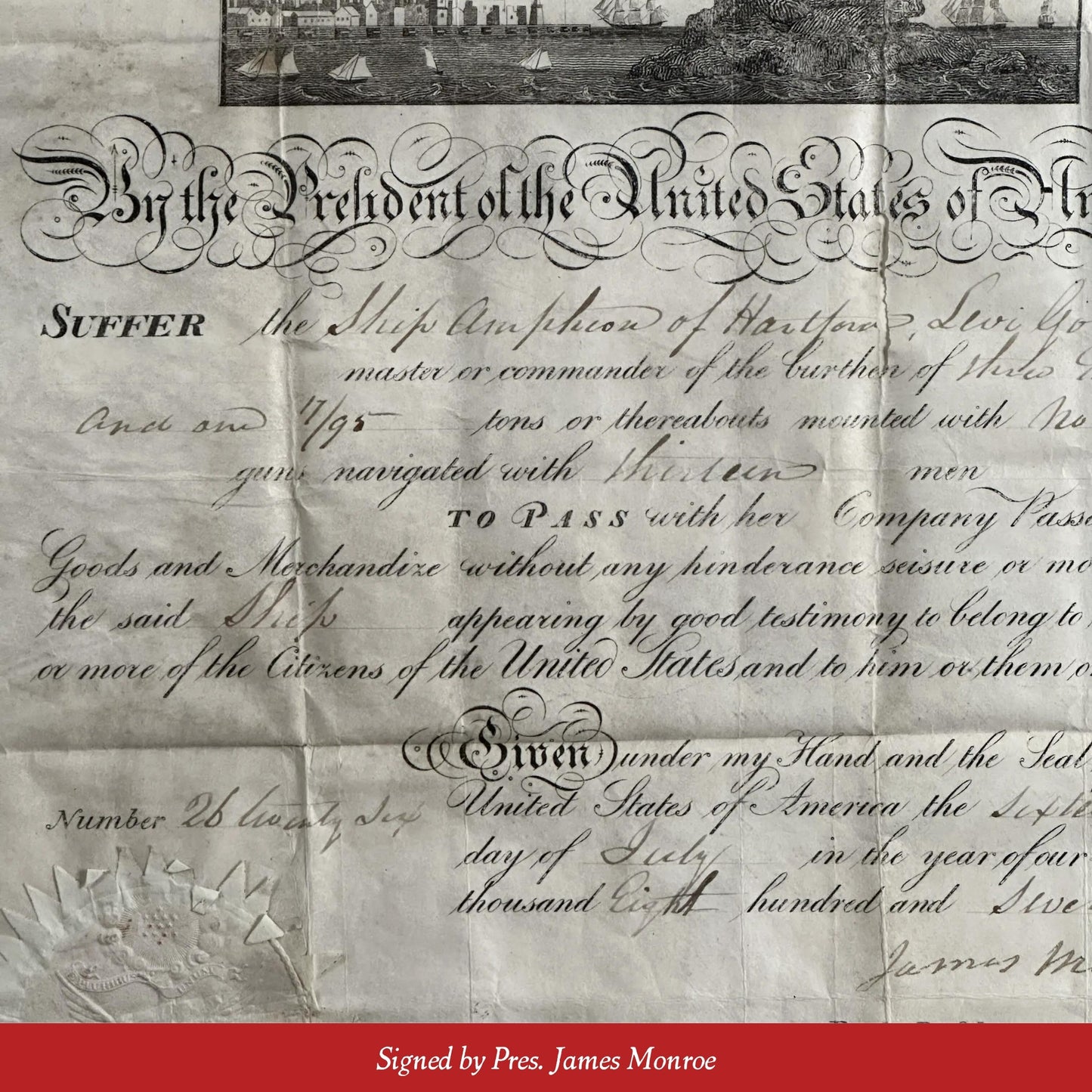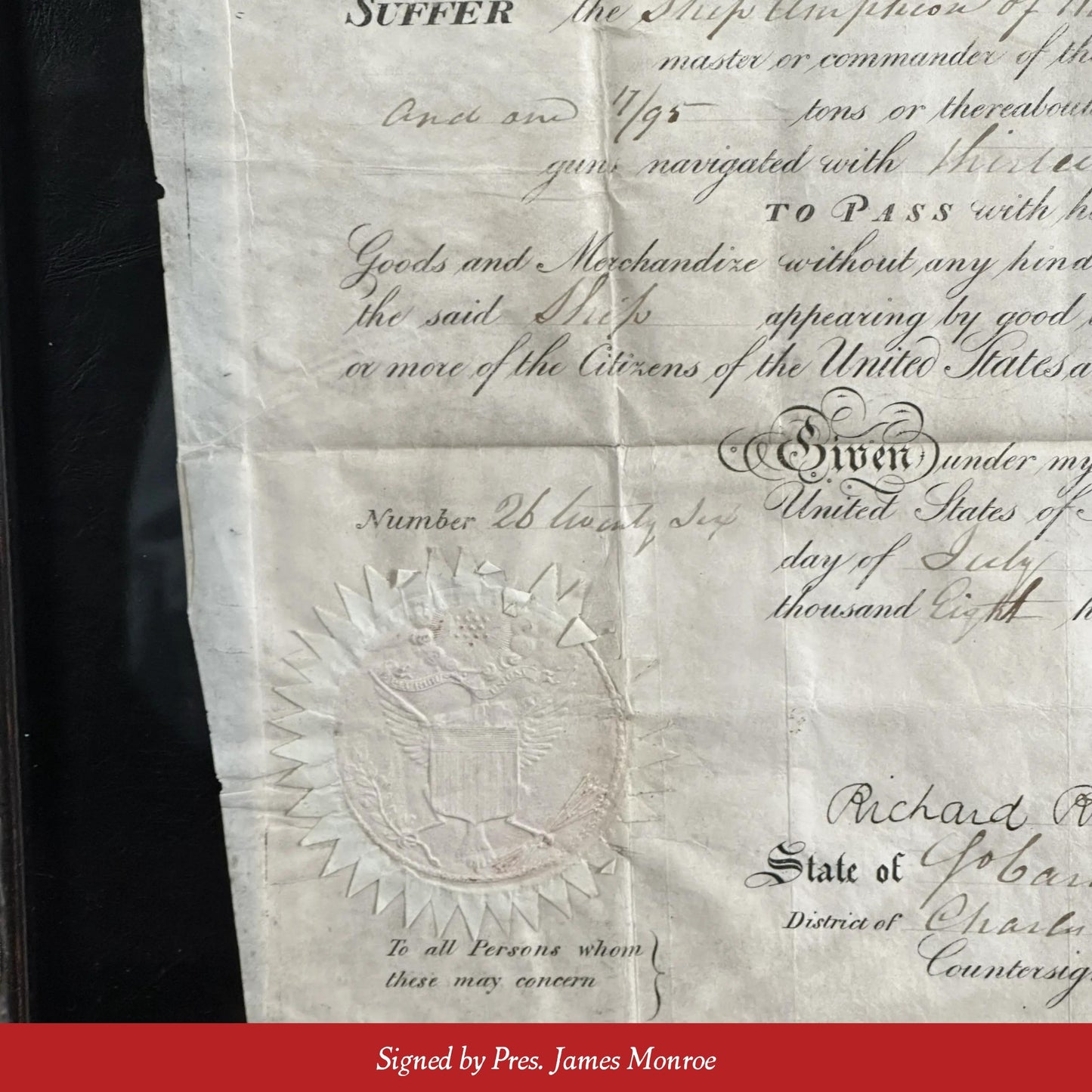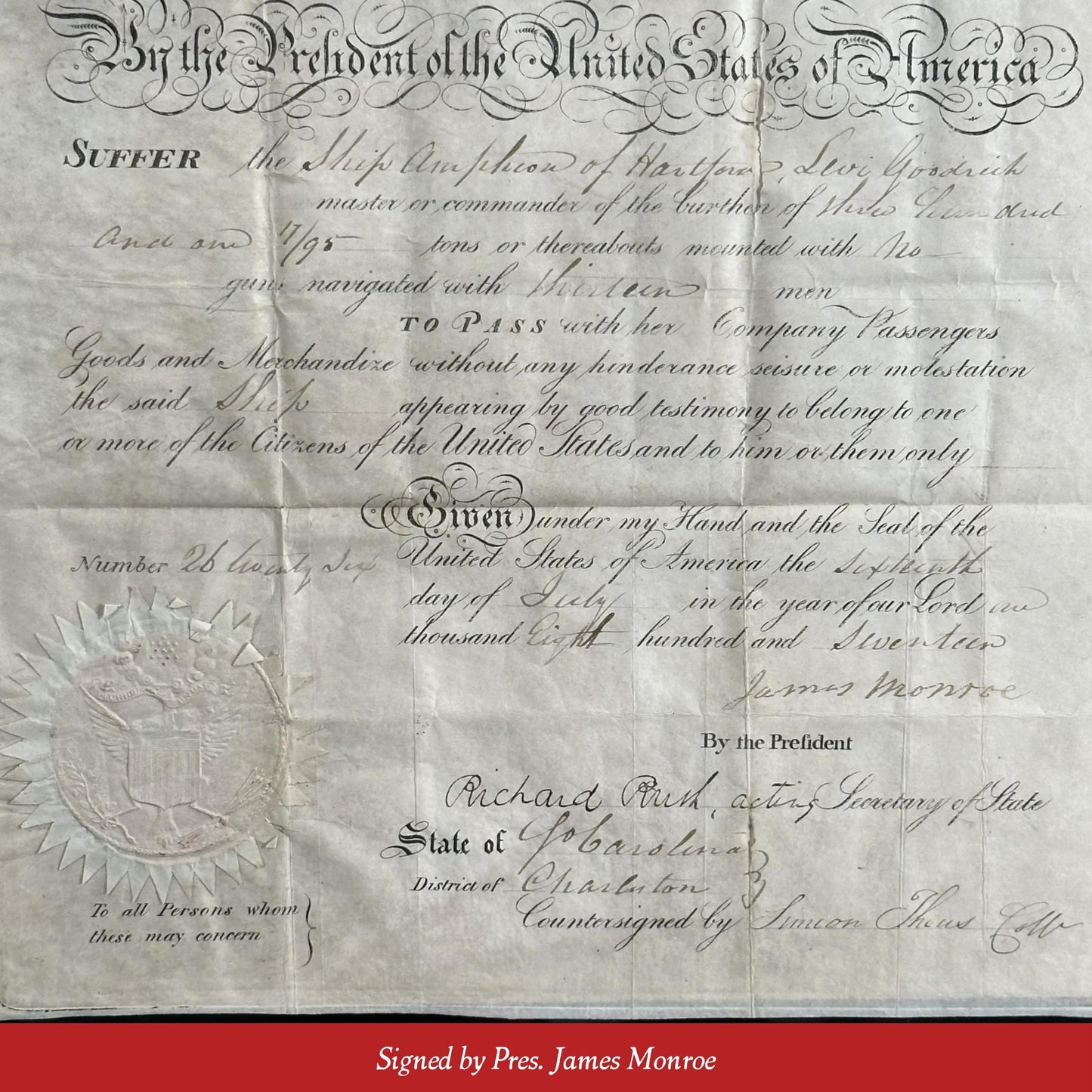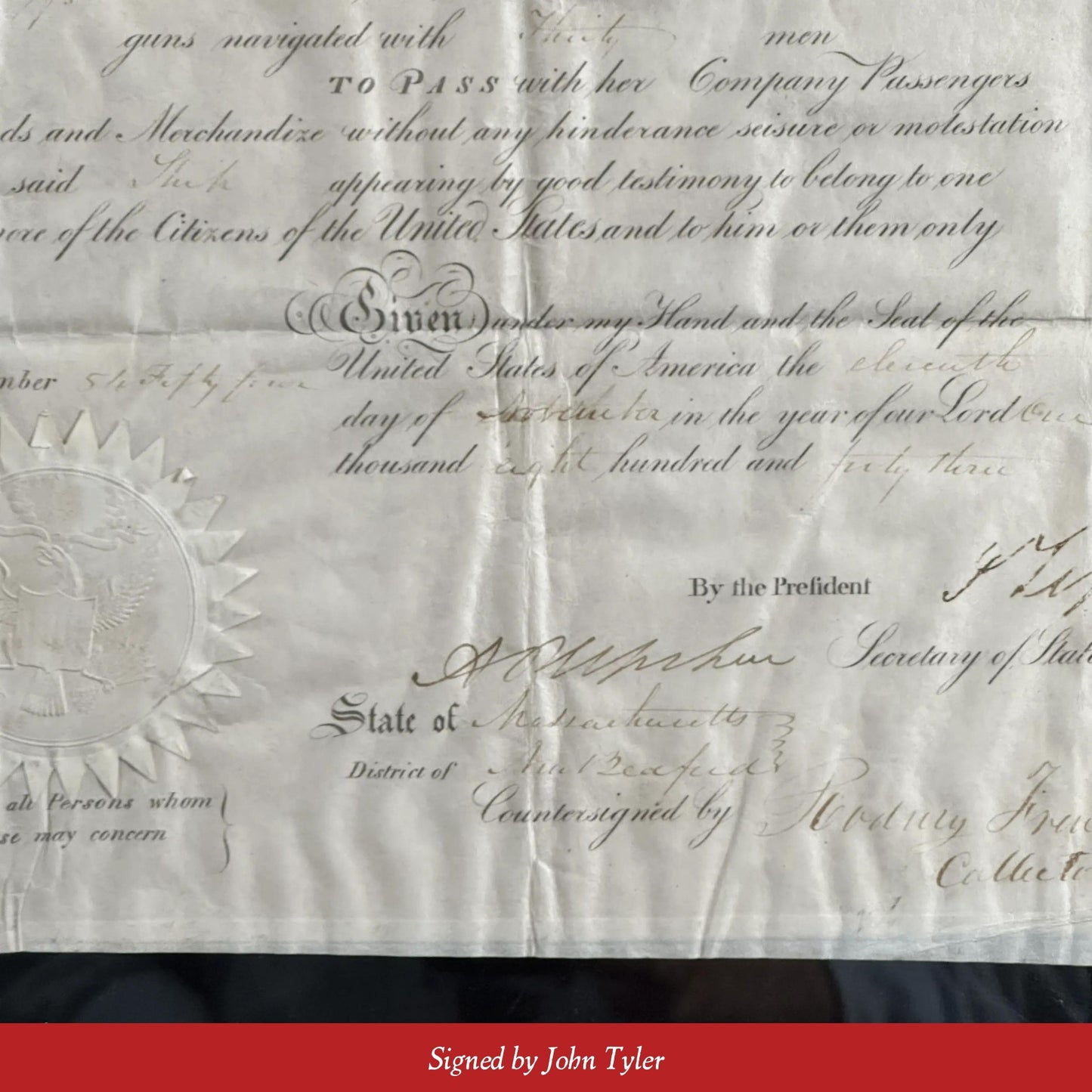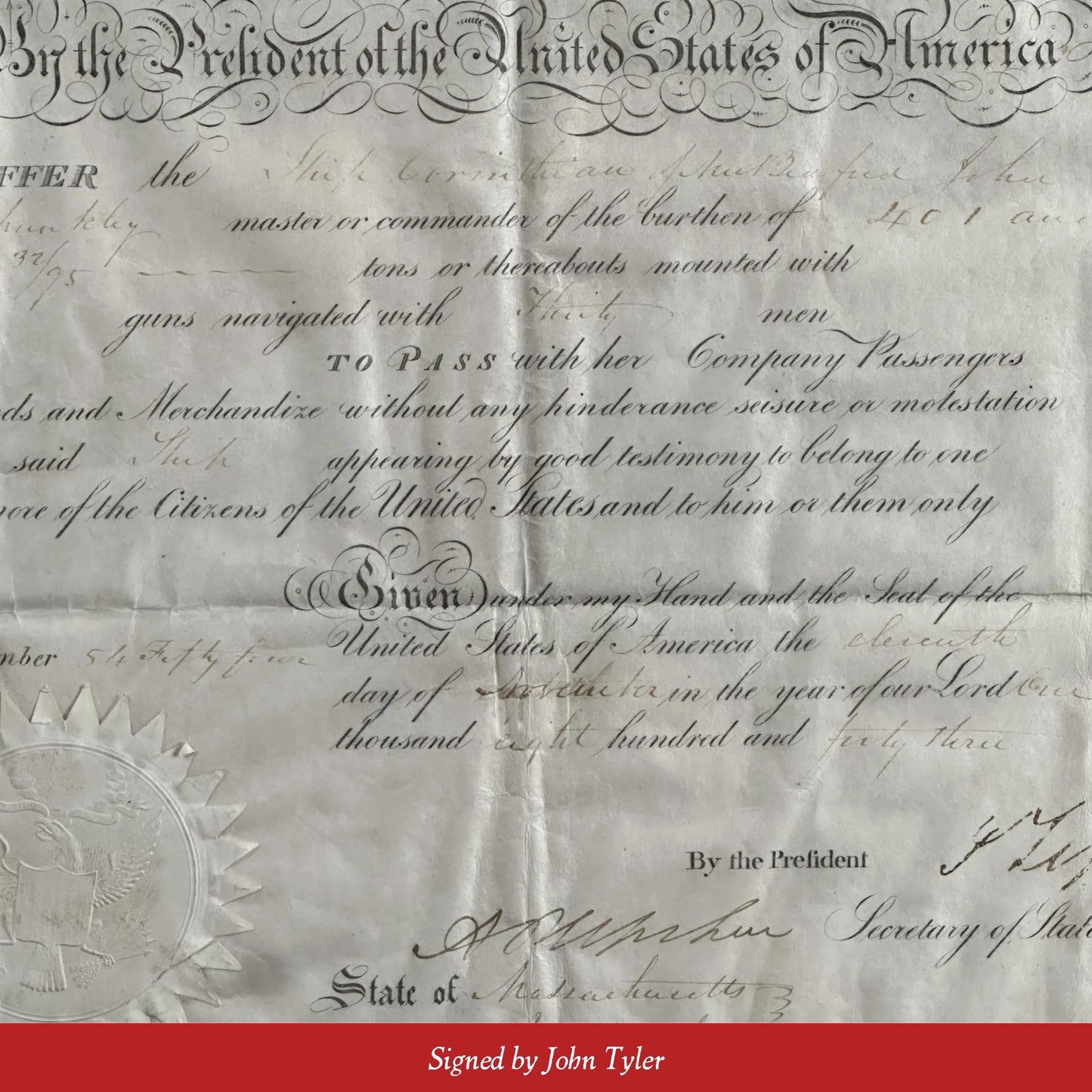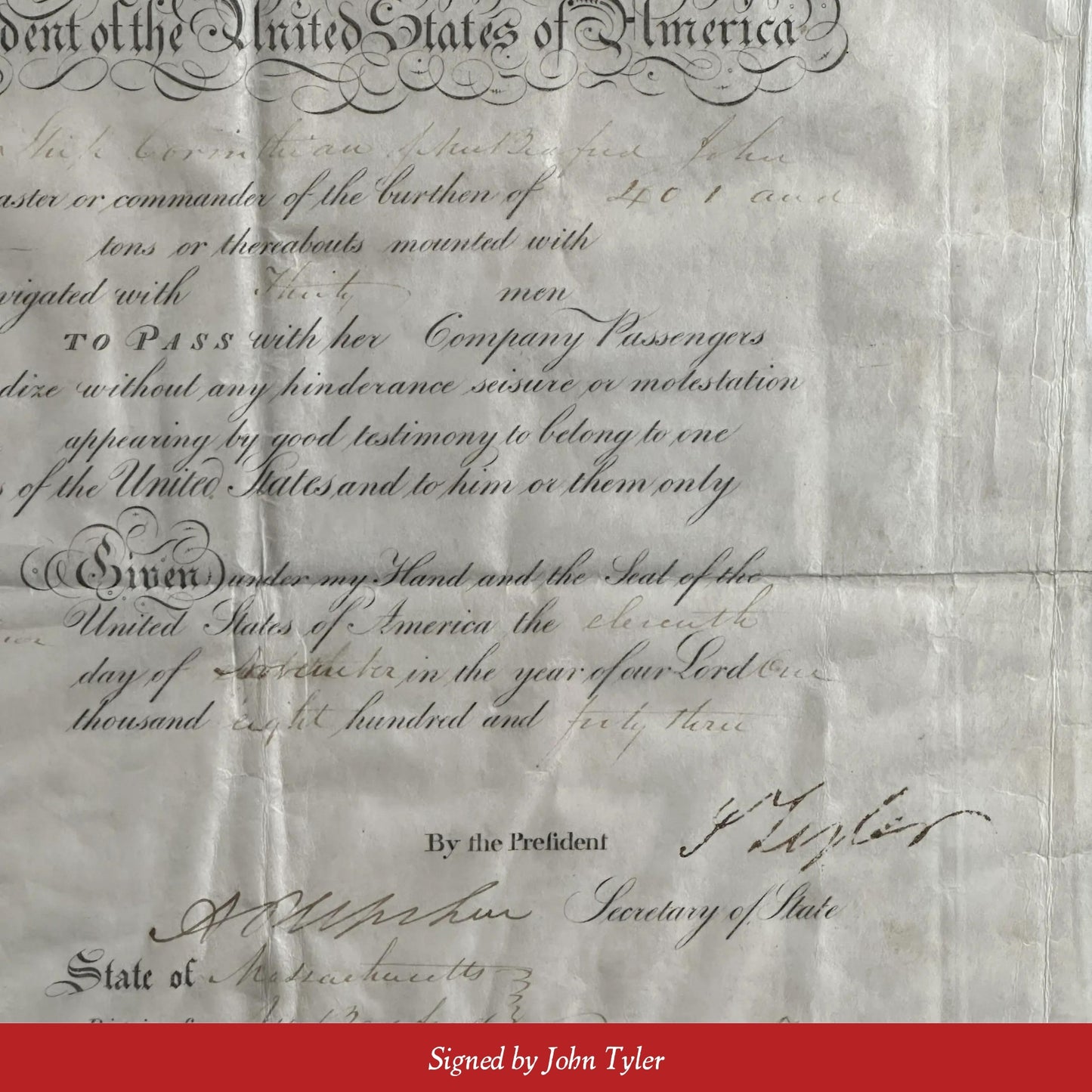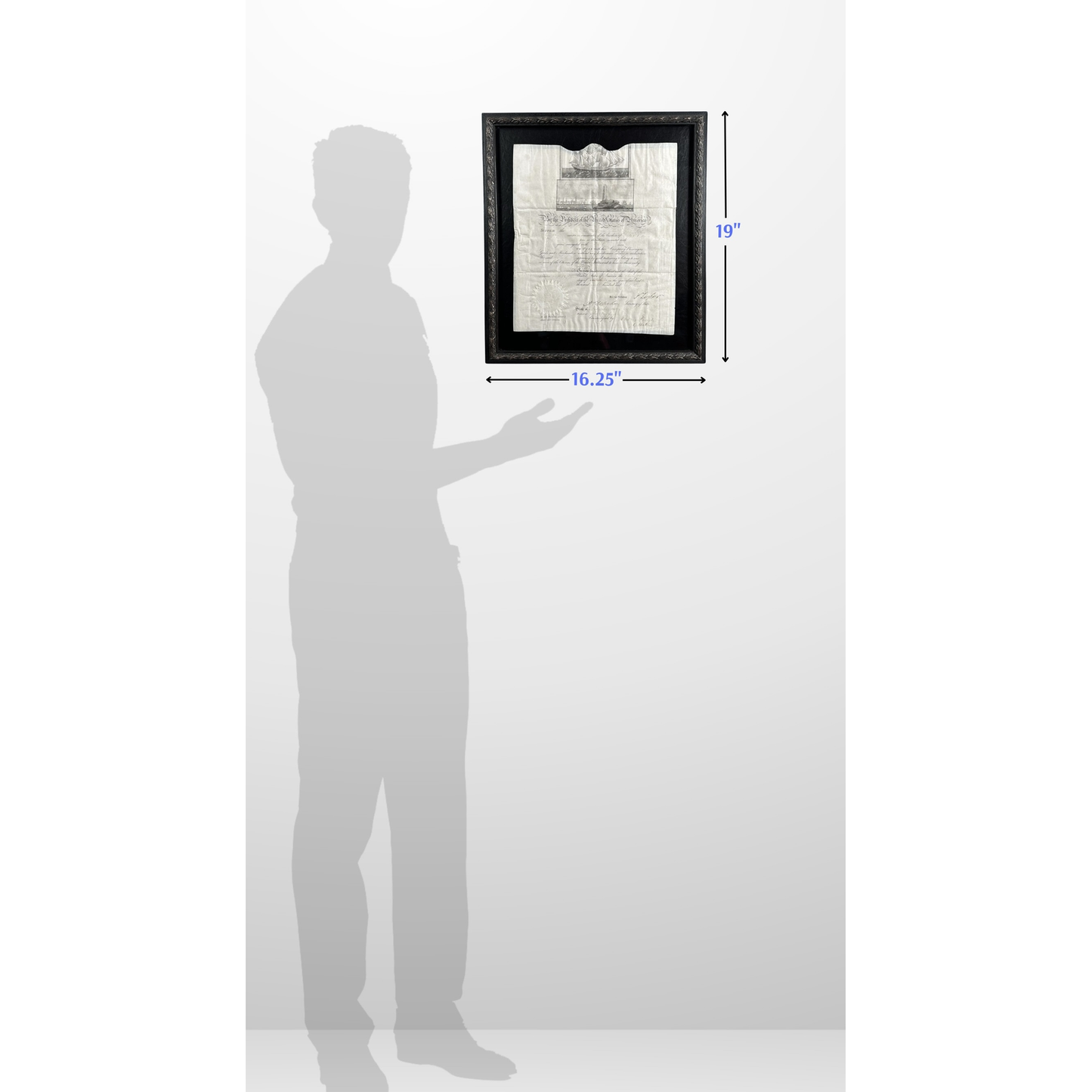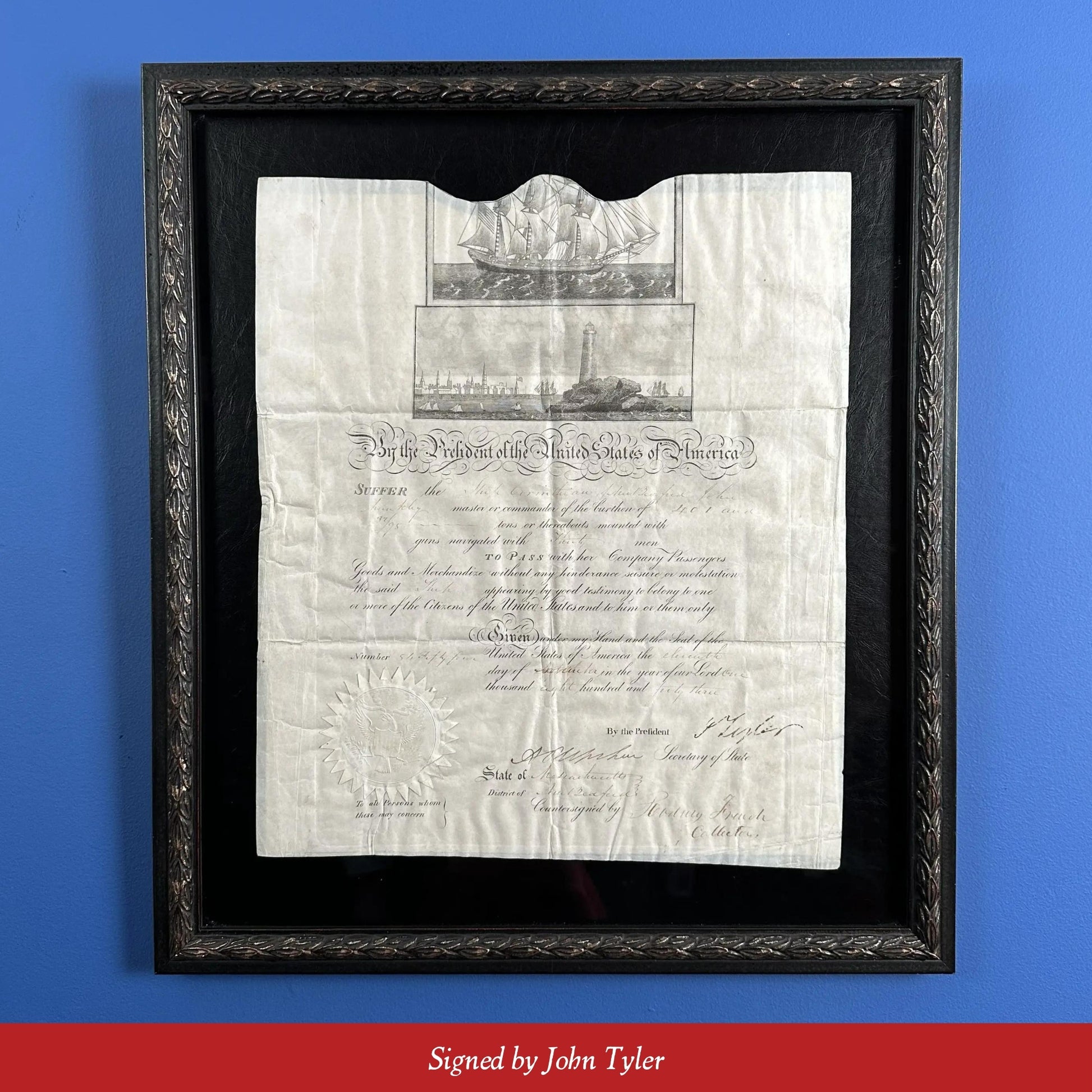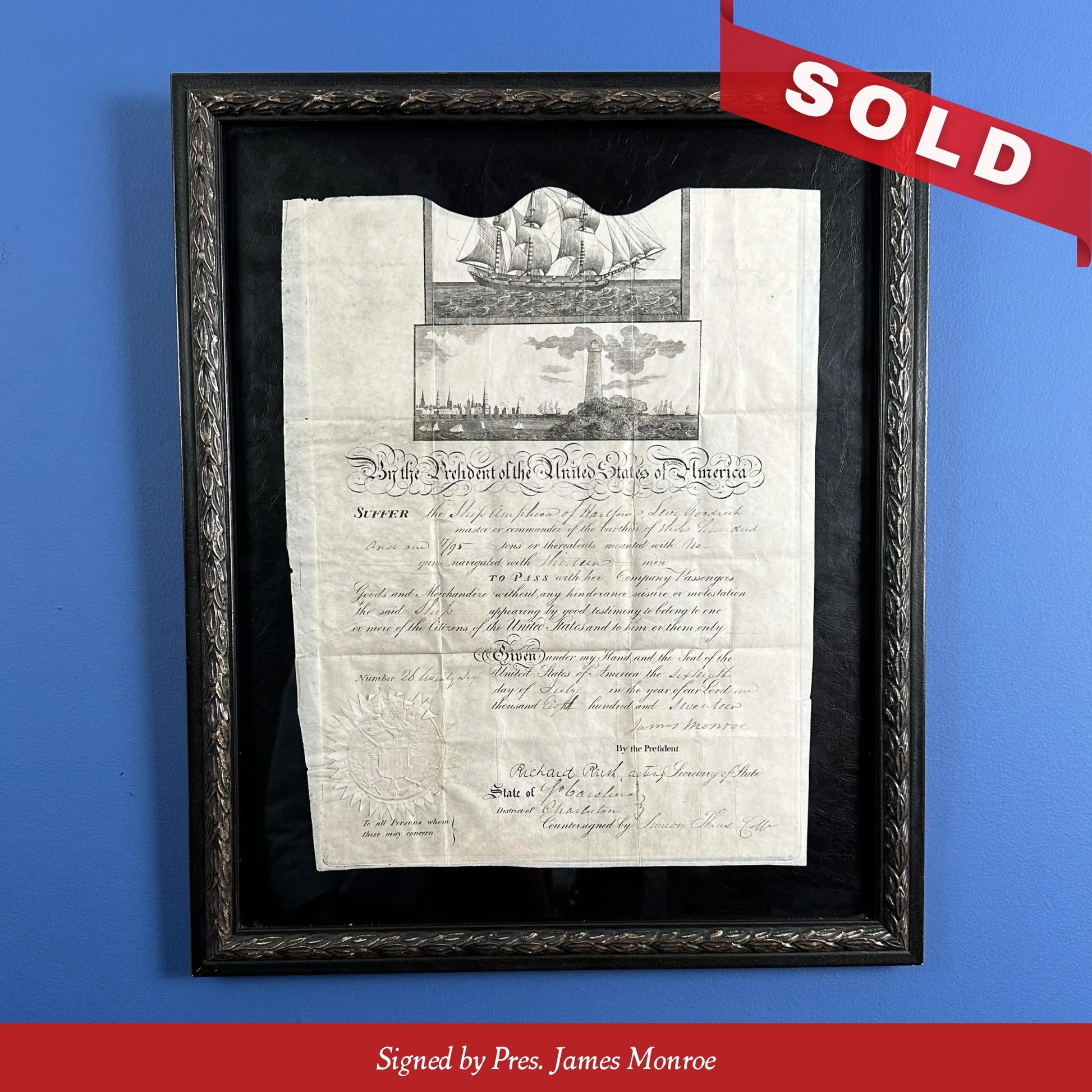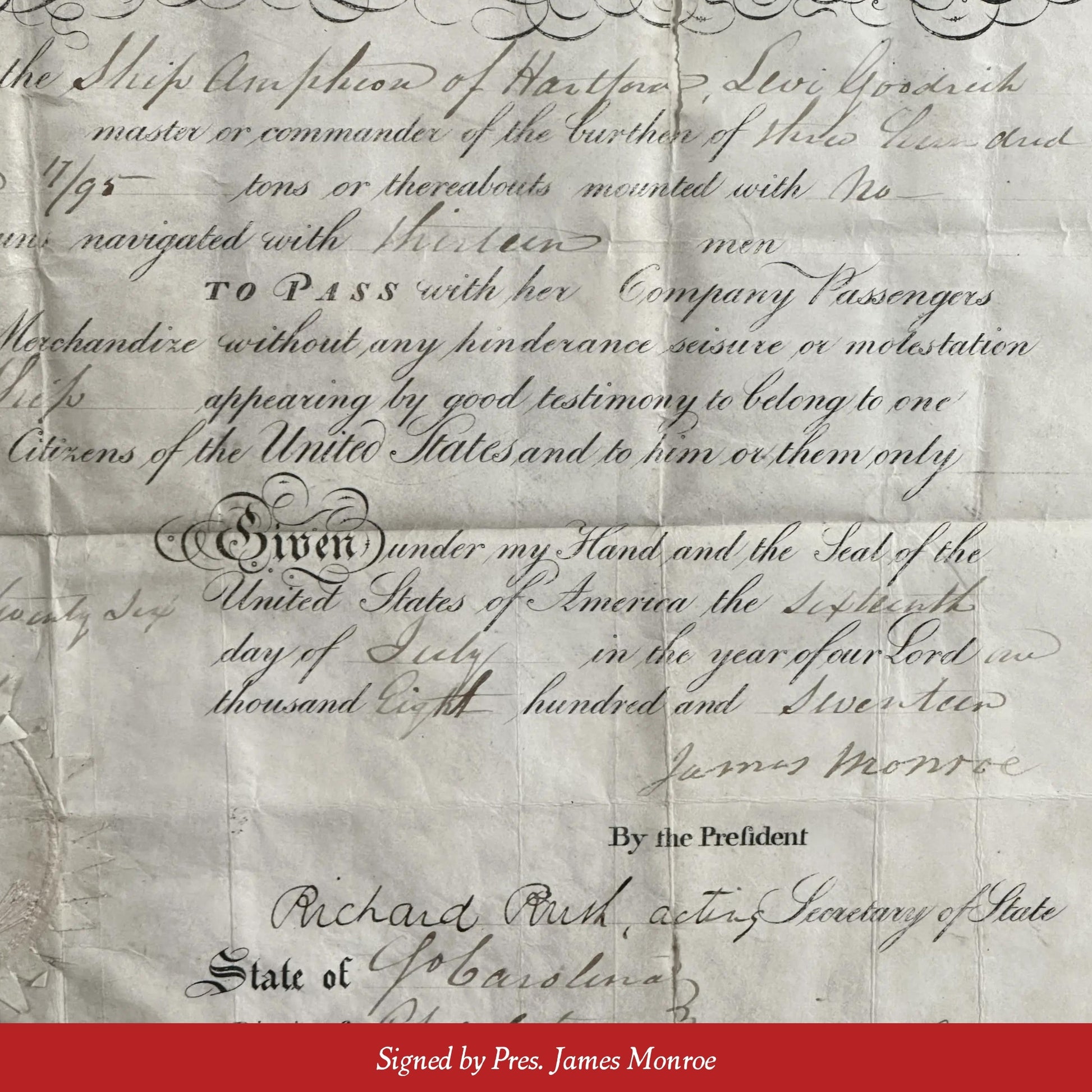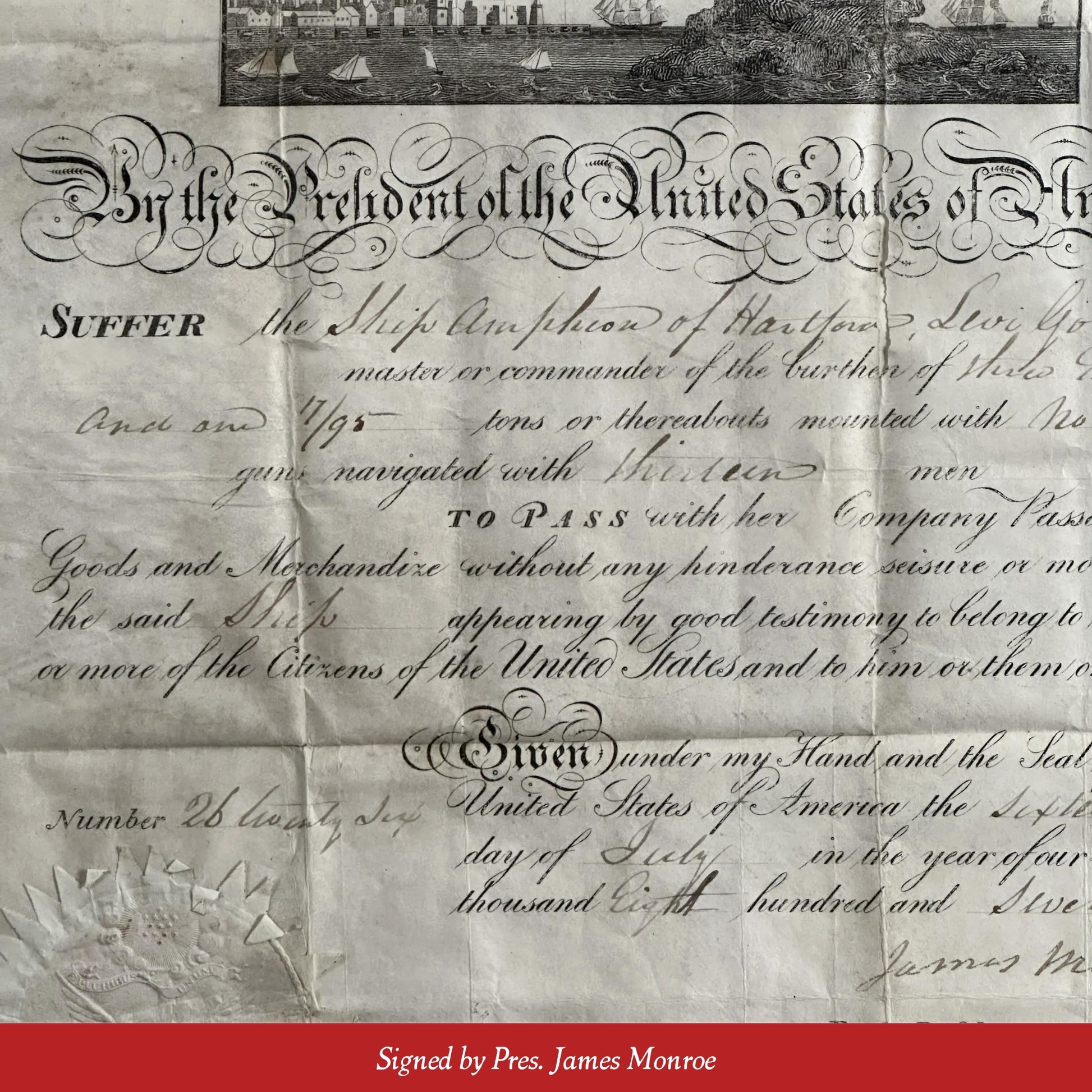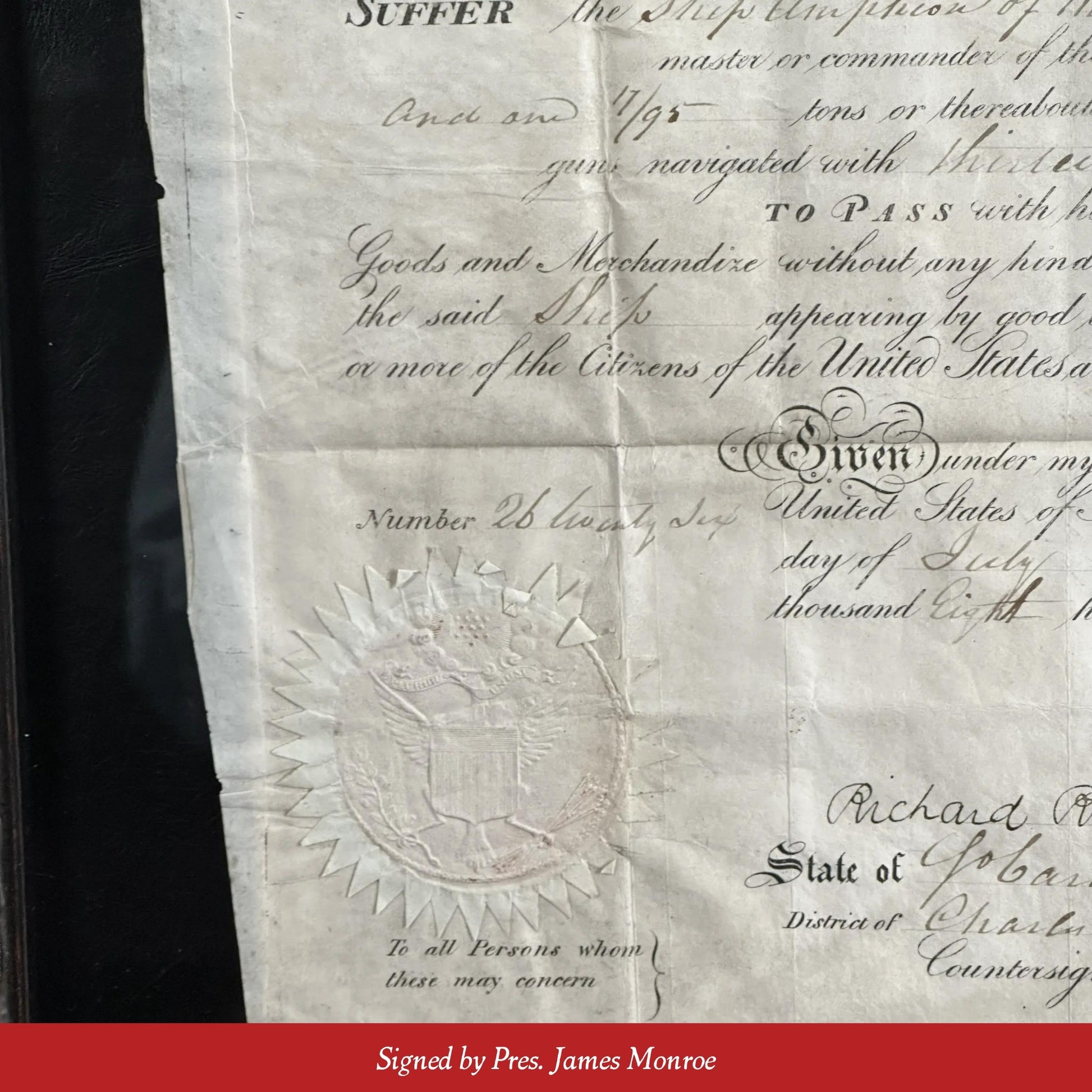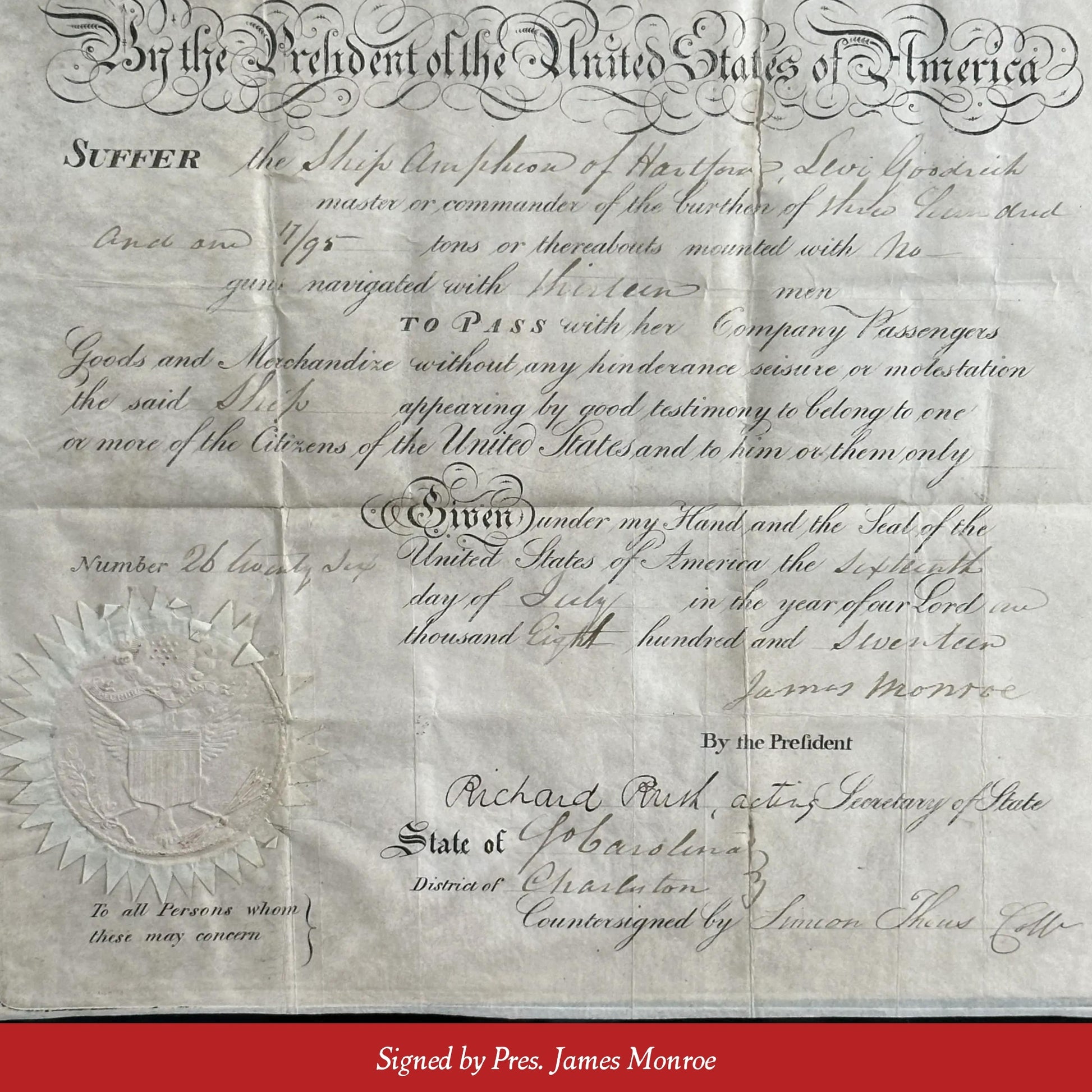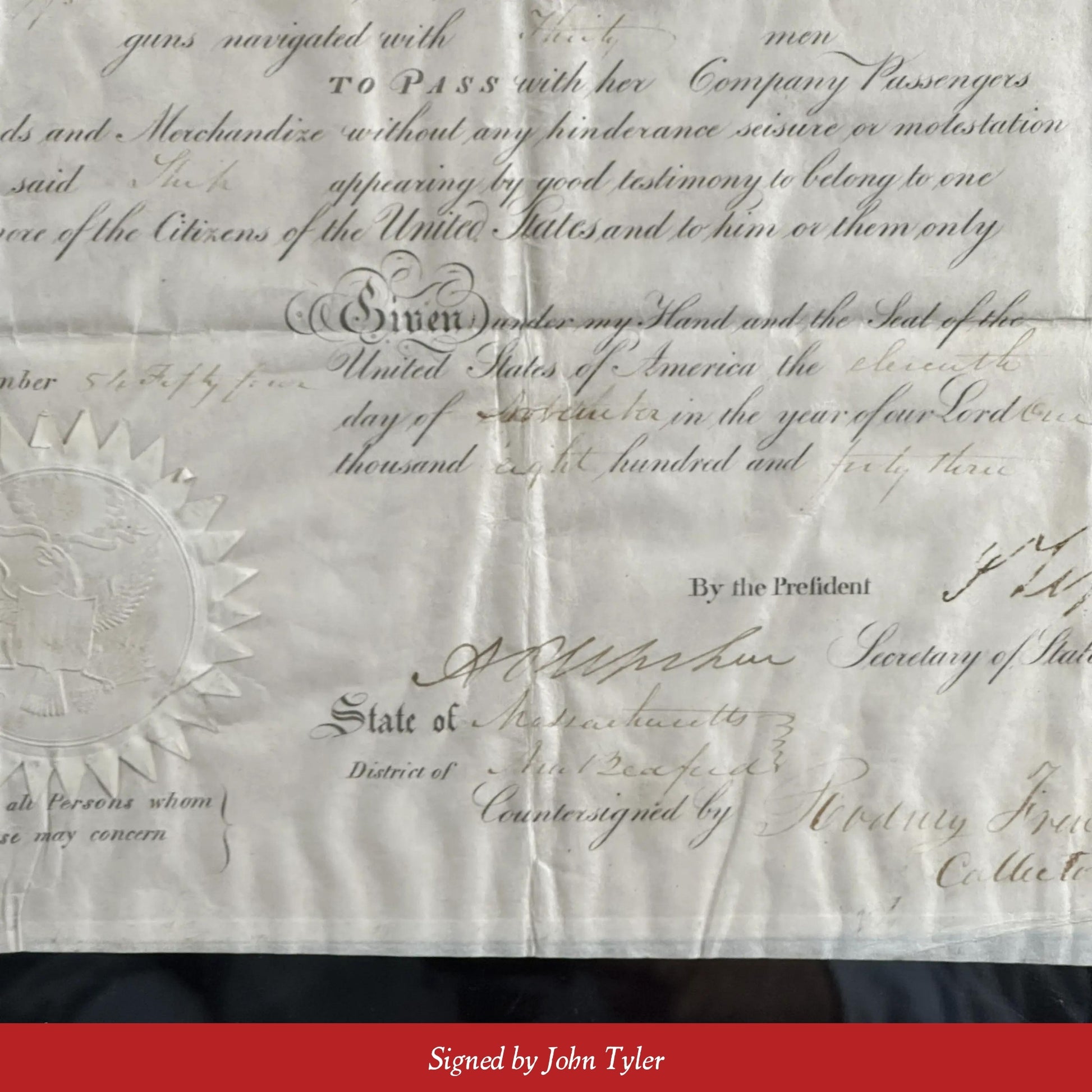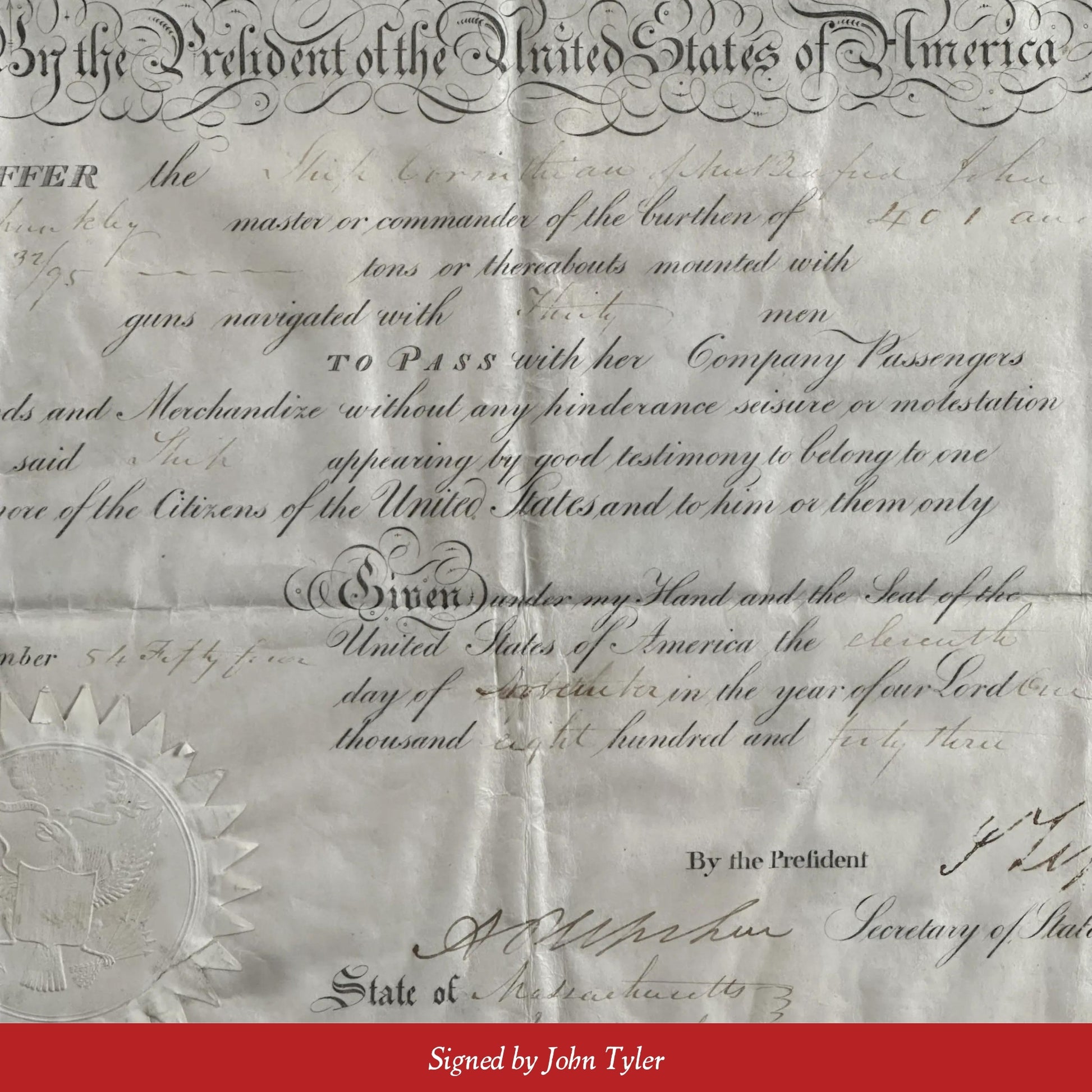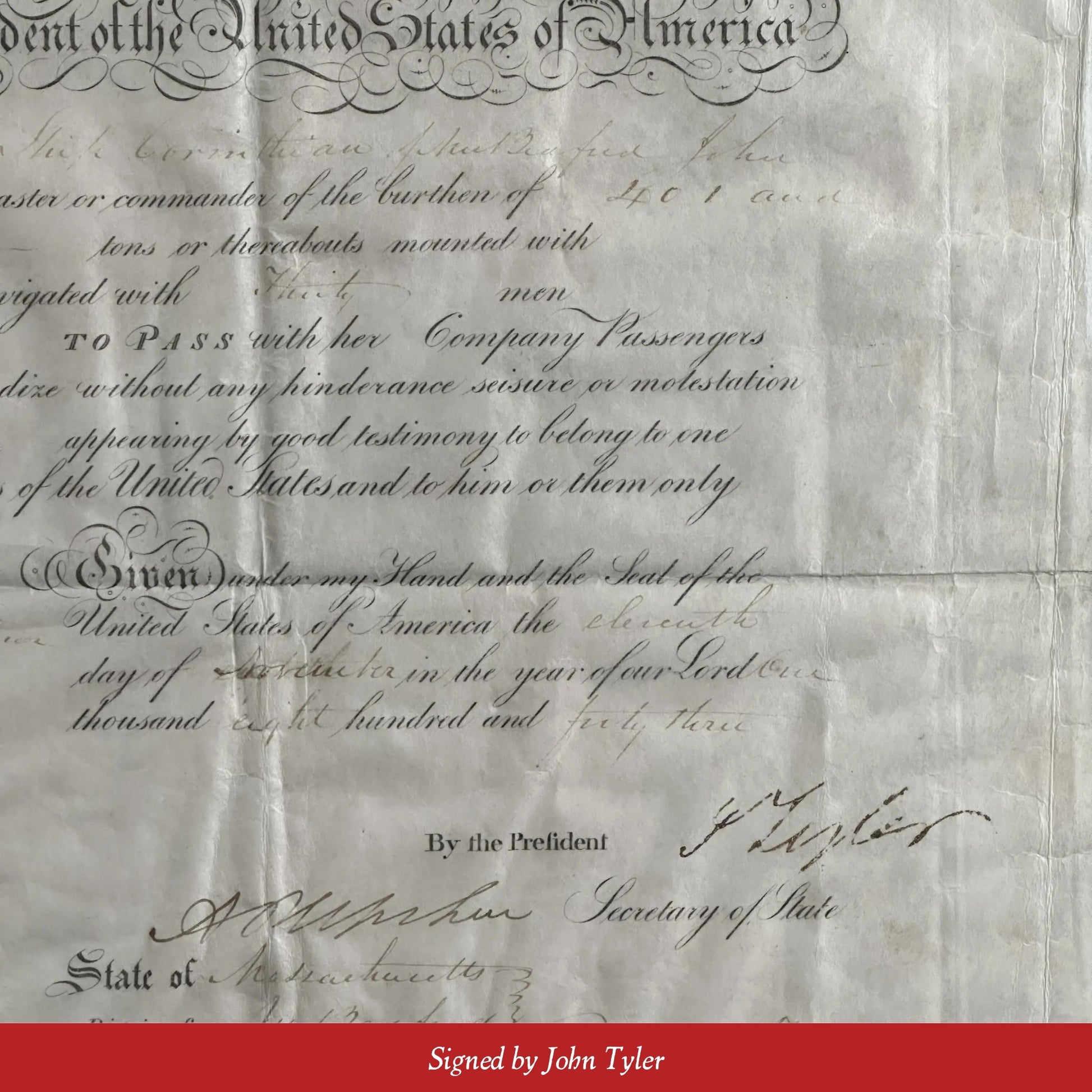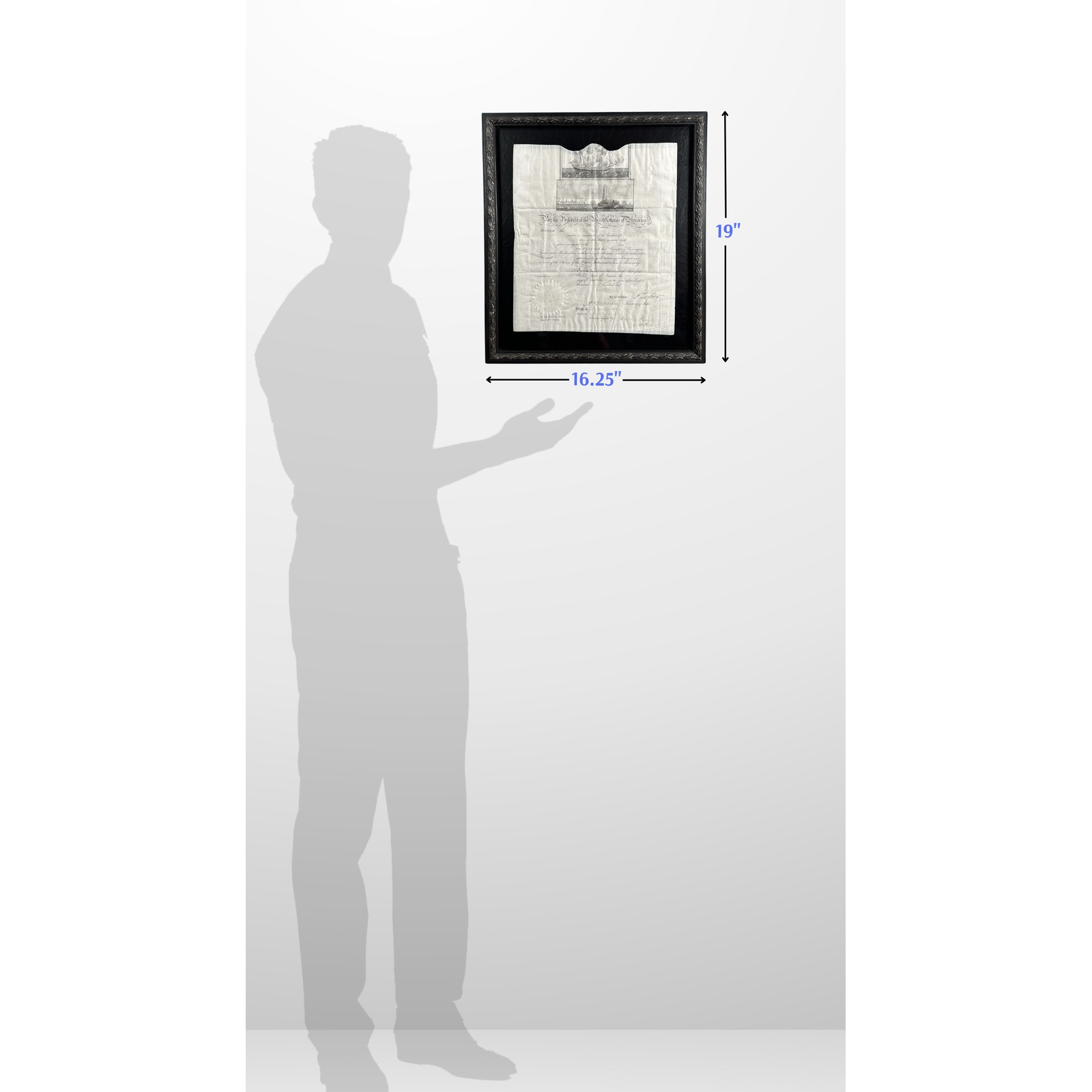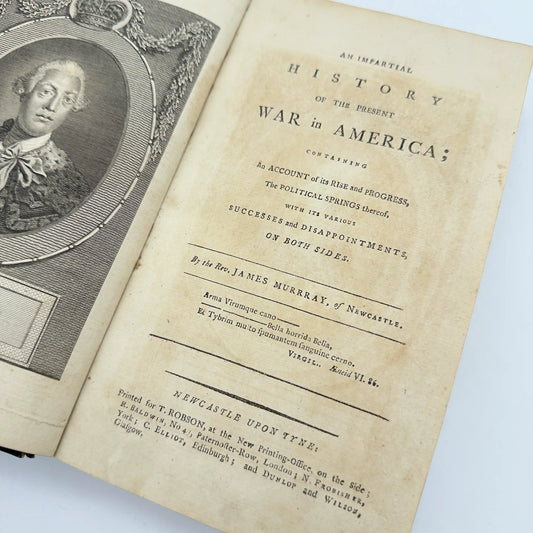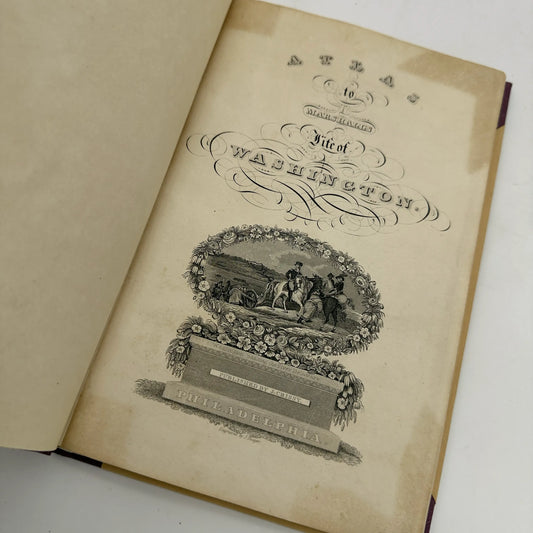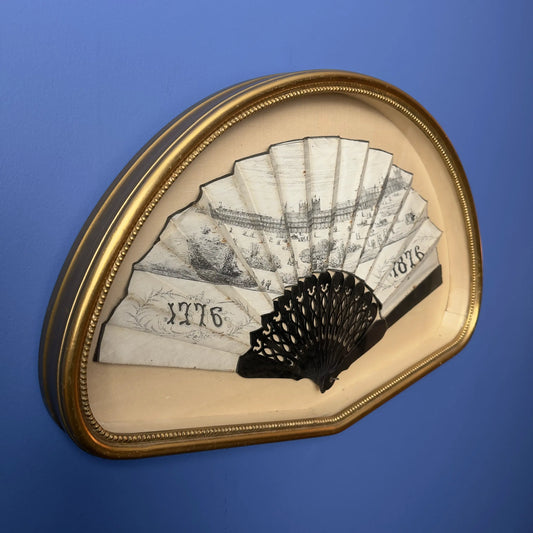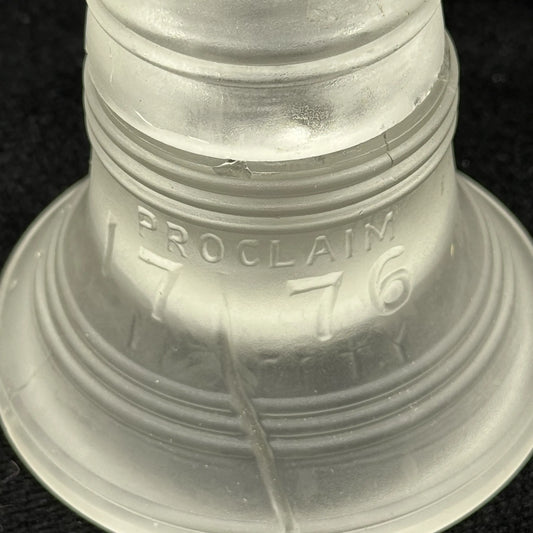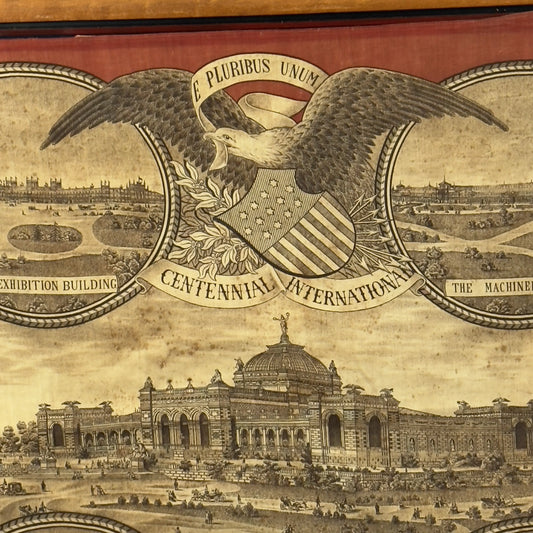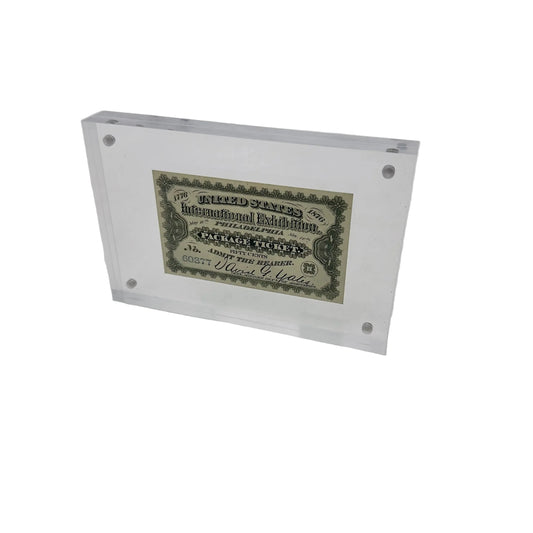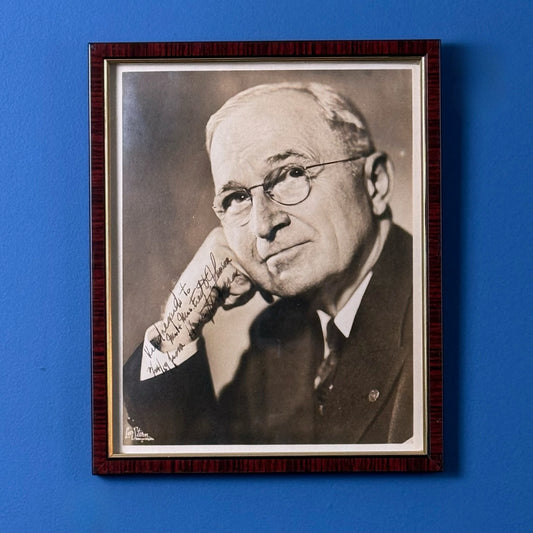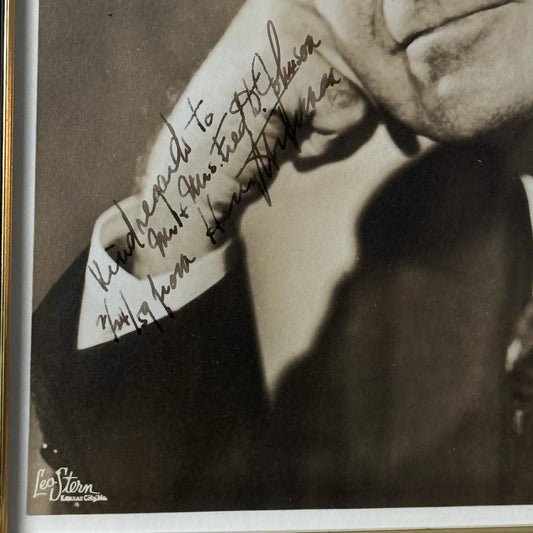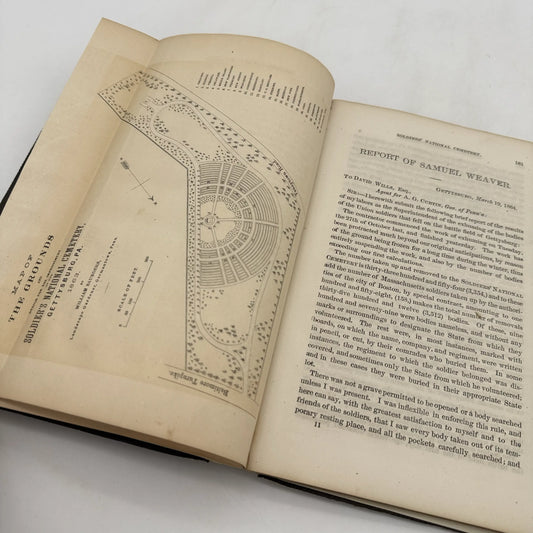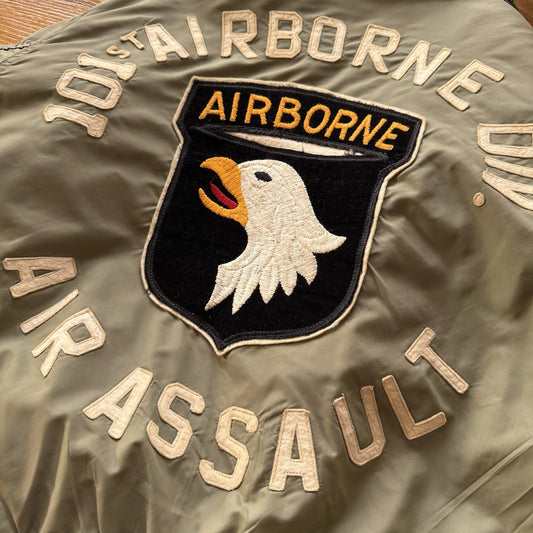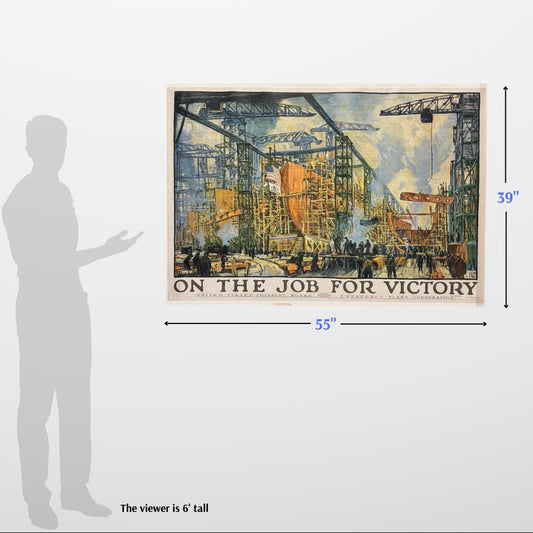Ship's Passport - Signed by President John Tyler for "Ship Corinthian of New Bedford John Minkley"
Ship's Passport - Signed by President John Tyler for "Ship Corinthian of New Bedford John Minkley"
Couldn't load pickup availability
Ship's Passport signed by President John Tyler
Partially engraved document accomplished in manuscript, signed (“J Tyler), as President and "A.P. Upshur" as Secretary of State, countersigned by "Rodney French Collector" for Massachusetts and New Bedford on 11 November 1843.
1 page, folio, on scalloped-topped vellum, with the United States Seal at the lower left.
A ship's passport for the "Ship Corinthian of New Bedford John Minkley."
More information on these important historical documents is below.
The log book for a shipped also named the Corinthian under Valentine Lewis on a whaling voyage July 24, 1859 - June 6, 1862 is available to browse online. (Note that I'm not certain that it's the same ship, though the name is the same and the home port is the same.)
Encased in an antique frame under Tru Vue Conservation Clear® Glass that offers 99% UV Protection.
Image size: 11.5" x 14.75"
Frame size: 16.25" x 19"
Shipping: $30. Please allow two weeks for shipping.
Note: When initially listed, there was also a Ships' Passport signed by James Monroe. That has been sold.
More information on the Ships' Passport signed by James Monroe — Sold
Engraved ship's passport signed by President James Monroe and acting Secretary of State Richard Rush on July 16, 1817. The one-page folio, printed on vellum, is Passport No. 26 issued in Charleston, South Carolina.
The document details the "Ship Amphion of Hartford," commanded by Levi Goodrich. Described as "of the burthen of three hundred and one 17/95 tons," the ship is noted to be mounted with "no guns" and navigated by "thirteen men." It is countersigned for the State of South Carolina, District of Charleston, and endorsed by customs collector Simon Theus. The Seal of the United States is affixed at the lower left corner.
On the reverse, there is a docket from July 1, 1811, from the District and Port of Savannah, Georgia. It reads: "...R. Halsey having taken the oath required by law—is at present master of the within named vessel.
Historical background on Framed Ships’ Passports and Sea Letters
"The Mediterranean Passport, commonly called a ship’s passport, was created after the United States concluded a treaty with Algiers in 1795. During the early years of independence, America was one of several nations paying tribute to the Barbary states in exchange for the ability to sail and conduct business in the Mediterranean area without interference. This treaty provided American-owned vessels with a “Passport” that would be recognized by Algeria and later by other Barbary states through similar treaties. These Passports were to be issued only to vessels that were completely owned by citizens of the United States, and were intended to serve as additional evidence of official nationality.
"In June 1796, a Federal law was passed which required the Secretary of State to prepare a form for the Passport and submit it to the President for approval. The result was a document modeled after a similar British form, called a Mediterranean Pass, which England had employed for the same purpose. The American version was a printed document, on vellum, that measured approximately 15 inches X 11 inches. Centered in the upper half were two engravings, one below the other (some early examples had a single large engraving of a lighthouse with a ship at anchor across the entire top quarter of the document). Signatures of the President of the United States, Secretary of State, and Customs Collector appear in the lower right-hand corner. The United States seal is in the lower left-hand corner…After they were printed, the Passports were cut along the waved line and the top portion sent to the U.S. Consuls along the Barbary coast. The Consuls subsequently provided copies to the corsairs, whose commanders were instructed to let all vessels proceed, who had passes that fit the scalloped tops.
"Every American vessel sailing in this area was to have a Mediterranean Passport as part of its papers. The penalty for sailing without one was $200.00. The master requested the document from the collector and paid a fee of ten dollars. A bond was also required to insure that the Passport was used in accordance with the conditions under which it was obtained, and was canceled when the document was forfeited. New Passports were not required for each succeeding foreign voyage, but it could not be transferred to another vessel, and it was to be returned to the port of original issue if the ship was wrecked or sold.
"Mediterranean Passports were received by the various customs districts pre-signed by the President and Secretary of State. The Collector could then insert the vessel’s name and tonnage, master’s name, number of crew members, and the number of guns mounted on the vessel, into the appropriate clanks and sign the document…Unused and outdated Passports were supposed to be returned to the Treasury Department, after first being canceled by cutting holes through the seals."
About Sea Letters
"Unlike the Mediterranean Passport, the Sea Letter does not appear to have had any formal establishment, but rather acquired validity through years of maritime use. The term “Sea Letter” has been used to describe any document issued by a government or monarch to one of its merchant fleet, which established proof of nationality and guaranteed protection for the vessel and her owners . . .
"The 1822 edition of The Merchants and Shipmaster’s Assistant described the Sea Letter as a document which “specifies the nature of the cargo and the place of destination,” and says that is was only required for vessels bound to the Southern Hemisphere. It further “indicated that . . . this paper is not so necessary as the passport, because that, in most particulars, supplies its place . . .” In 1859 the document was defined as part of the ship’s papers when bound on a foreign voyage, . . . is written in four languages, the French, Spanish, English, and Dutch, and is only necessary for vessels bound round Cape Horn and the Cape of Good Hope.
"Like the Mediterranean Passport, the Sea Letter was a remarkably standardized document, which changed little during the time that it was used. Usually printed on heavy grade paper, approximately 16 inches x 20 inches in size, the first Sea Letters carried only three languages instead of four. However, they soon became known as “Four Language Sea Letters.”
"The statement within the document conveys in part that the vessel described is owned entirely by American citizens, and requests that all “Prudent Lords, Kings, Republics, Princes, Dukes, Earls, Barons, Lord, Burgomasters, Schepens, Consullors…” etc., treat the vessel and her crew with fairness and respect. The signatures of the President of the United Stated, the Secretary of State, and the customs collector appear, usually in the middle portion of the document, The United States seal is present, while customs and consular stamps or seals are frequently in evidence.
"Sea Letters are mentioned in the formative maritime legislation forged by the new Federal governments. Like passports, they provided additional evidence of ownership and nationality, but the criteria by which a shipmaster utilized one document over the other is not completely clear. It was explained at the time that both documents were “rendered necessary of expedient by reason of treaties with foreign powers,” a statement which suggests that certain nations required a particular document because of existing agreements with the United States.
"…The Sea Letter was valid for only a single voyage, and a bond does not seem to have been required. Neither was it to be returned to the collector when the voyage was completed. Indications are that, as the years progressed, Sea Letters were being used more often by whaling ships than by merchant vessels, perhaps because American whalers fished in areas where this document was preferred as proof of national origin.
"By providing a statement of American property, signed by the President of the United States, the Mediterranean Passport and the Sea Letter were intended to confirm our status as a neutral nation, when international conflict put added dangers on America’s commerce at sea. By mid-century, however, much of what had previously threatened our shipping was being neutralized by the expanding power of the United States. In 1831, Congress eliminated the fee required for obtaining a Mediterranean Passport. It was argued at the time that the revenue arising from that source, and the protection which it provided, were no longer objects of any importance. As our merchant fleet became more secure, fewer ship owners and shipmasters considered these documents as necessary to guarantee their rights and safety in foreign lands.
"Both pieces were considered important parts of a ship’s papers in the 1800s. They were kept aboard ship during the voyage and deposited, along with the Registry Certificate, with the appropriate U.S. consular authority anytime the vessel was in a foreign port. The Mediterranean Passport had disappeared from use by 1860, while the Sea Letter was still in evidence several years later.
"Today both pieces are considered to be important documents in any maritime collection. However, they are also highly valued by autograph collectors and investors, which keeps many fine pieces in private hands.
"Of note, the passports were actually issued by the Collectors of Customs in the various ports. With the slowness of transportation, it was impossible for the President and Secretary of State to sign documents in a timely manner for specific ships. Therefore, blank passports were signed by the President and the Secretary of State and Sealed with the Great Seal of the United States. Then groups of these signed documents were transported to the ports, where they would be issued as needed by the Collectors of Custom. As a check, they were usually notarized at the time of issuance and the document carried both the date of issuance and the signature and seal of the notary. This process occasionally resulted in a posthumous issuance of a passport after the signing President had died."
[Excerpt from American Maritime Documents 1776-1860 by Douglas L. Stein.]
Made by America
Made by America
Almost all of the new products we offer are designed by us and made in America and most of our Rare Finds were made in America.
Our original designs are based on our nation’s history and our love of American history. Read more about other things we've created, including The History List, History Camp, and The Pursuit of History, in addition to The History List Store.
Every product that is made in America states that in the product description and includes the "Made in U.S.A." graphic.
